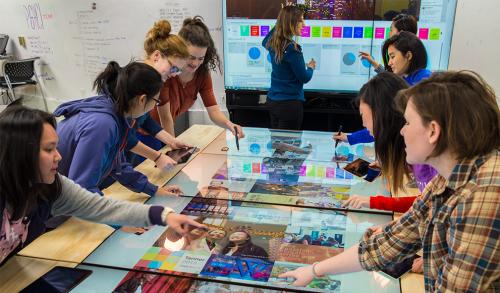Imagine working on a table-sized multitouch computer with classmates or colleagues, then transferring your work to a hand-held device with one tap or swipe. Sound futuristic? The future is here. Eight MultiTaction displays, which support collaborative interaction using touch, tagged objects, infrared pens, and personal devices, were recently installed in the Wellesley Human-Computer Interaction (HCI) Lab. The Computer Science Department purchased the displays using part of a $479,631 research infrastructure grant from the National Science Foundation, awarded to support the creation of an interactive visualization facility for interdisciplinary research.
"The goal of this new facility is to become an important focus of interdisciplinary research for members of the Wellesley community," said Orit Shaer, associate professor of computer science and director of the lab. "Research projects using this facility will address important questions regarding the use of interactive visualizations for collaborative exploration of large data sets in various domains ranging from genomics and chemistry, to social computing, learning analytics, and digital humanities."
Projects will include interactive visualizations of personal genomics information for medical research, and collaborative decision-making using TwitterTrails—a Wellesley-designed tool that tracks the trustworthiness of stories shared on Twitter. The facility will also support the exploration of molecular models using touch, and facilitate collaboration among novice programmers.
"The applications of this technology are far-reaching and could impact many fields," said Shaer. "Imagine if a group of scientists could sit in a conference room together, explore various data visualizations collaboratively, identify trends, and share insights. That could impact whether and how new research hypotheses and scientific discoveries are developed."
The facility could also be used to simplify complex tasks that involve multiple staff members and hundreds of documents, such as the admissions process, or conference planning, where a panel must decide which papers to accept.
Shaer points out that the availability of exciting technology is not all that is required to design effective collaborative environments. "We also need a deep understanding of how different design characteristics of the environment will affect users’ ability to collaborate," she said. "We are investigating how this new facility can help users solve problems that require visualizing and manipulating data in various formats, collecting and assessing quantitative and qualitative input from multiple co-located participants, and, finally, taking some action, such as ranking items on a list, or initiating an activity."
Before the lab was fully functional, Shaer and her colleagues had begun using the state-of-the-art technology to develop innovative projects both on and off campus. Evan Segreto '15, a computer science major who is now a research programmer in the HCI lab, developed the Wellesley Experience, an application that allowed members of the community to explore the Wellesley Effect priorities during the recent campaign launch. Alumnae walked up to a blackboard-sized screen, touched a subject area that interested them, then sent that information to their personal email addresses by tapping their nametags against the screen.
Shaer's team also used the new displays to design and develop an interactive museum exhibit on synthetic biology in collaboration with The Tech Museum of Innovation in San Jose, Calif. The exhibit will allow museum visitors to design new bacteria that might be helpful for surviving on Mars through multitouch interactions with virtual bacterial cells. "This project will make complex science accessible to the public in ways that other media could not," said Shaer. The exhibit, which The Tech Museum will launch in late spring, won a gold medal at the International Genetically Engineered Machine (iGEM) research competition this fall.
Wellesley is one of only a few higher-education institutions in the country that owns a MultiTaction facility. It will allow the HCI Lab to pioneer applications and potentially set the standard for other colleges and universities. "The NSF grant makes our work possible, and we are profoundly grateful," said Shaer, speaking on behalf of her department colleagues P. Takis Metaxas, professor of computer science, Eni Mustafaraj, assistant professor of computer science, Brian Tjaden, associate professor of computer science, and Franklyn Turbak, associate professor of computer science, who are named as co-principal investigators (PIs) in the grant.




